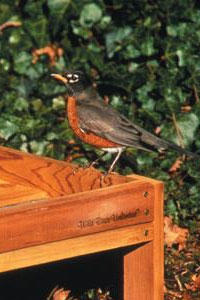BIRD OF THE MONTH: AMERICAN ROBIN
The American Robin is a member of the thrush family which also includes bluebirds, solitaires and wood thrushes. This bird can be found throughout North America at some time during the year. Male robins have a dark gray to almost black back and tail with a rust/brick colored breast. The female is paler all over. Juvenile robins have a spotted breast.
American Robins living in the western states tend to be paler in color and often lack the white markings on the outer corners of their tail.
American Robins eat a variety of insects and berries. Worms only make up about 15 - 20% of the summer diet for robins. It has been noted, however, that a single robin can eat up to fourteen inches of earthworms in a day.
When looking for earthworms, American Robins don't find them by hearing or smelling them. Robins find worms by cocking their head to one side, independently using each eye to look for visible signs of worms. You most likely will see American Robins in your yard after a rain or a mowing as this brings worms and insects to the surface.
American Robins change their feeding habits depending on the time of day as they will eat more earthworms early in the day when they are easier to find and then switch to fruit later in the day.
American Robins typically nest from April through July and can have 2 - 3 broods in a season. The female does the nest building and incubates the eggs alone. Upon hatching, both parents feed the average brood of four young.
Robins usually return to the same area to nest each year and may occasionally use last year's nest again after some renovation. Male robins that migrate usually arrive on the breeding grounds up to two weeks before the females return.
American Robins often forage for food on lawns thus making them vulnerable to poisoning, another good reason to maintain a pesticide free habitat.
Robin roosts can be huge sometimes totaling a quarter million birds during the winter.
The oldest known American Robin was 13 years 11 months old.


